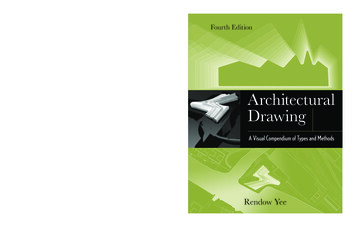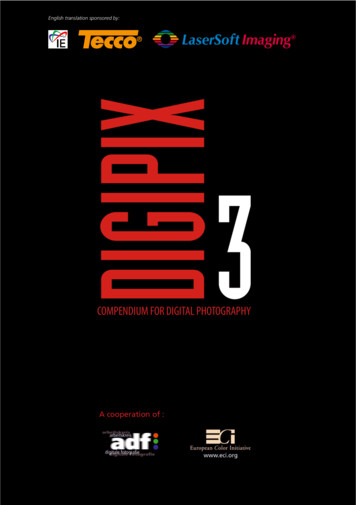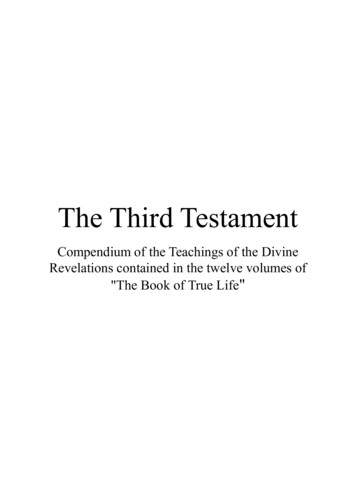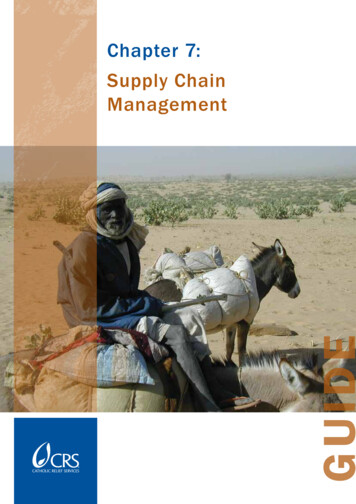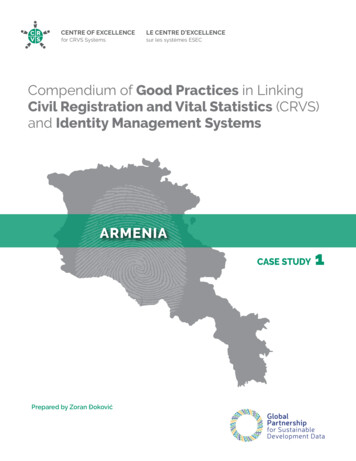
Transcription
CENTRE OF EXCELLENCELE CENTRE D’EXCELLENCEfor CRVS Systemssur les systèmes ESECCompendium of Good Practices in LinkingCivil Registration and Vital Statistics (CRVS)and Identity Management SystemsARMENIACASE STUDYPrepared by Zoran Đoković1
This publication is a single chapter in a larger body of work. The Compendium of Good Practices inLinking Civil Registration and Vital Statistics (CRVS) and Identity Management Systems was developedby the Centre of Excellence for Civil Registration and Vital Statistics Systems in collaborationwith the Global Partnership for Sustainable Development Data (GPSDD). The full compendium isavailable starting November 2019 at crvssystems.ca/IDcompendium.Published by the Centre of Excellence for Civil Registration and Vital Statistics Systems.PO Box 8500, Ottawa, ON, Canada K1G 3H9crvs@idrc.cawww.CRVSsystems.ca International Development Research Centre 2019The research presented in this publication was carried out with financial and technical assistancefrom the Centre of Excellence for CRVS Systems. Housed at the International DevelopmentResearch Centre (IDRC), it is jointly funded by Global Affairs Canada and IDRC. The views expressedherein do not necessarily represent those of Global Affairs Canada, IDRC, or its Board of Governors.
ARMENIACASE STUDY1ContentsFigures. . . . . . . . . . . . . . . . . . . . . . . . . . . . . . . . . . . . . . . . . . . . . . . . . . . . . . . . . . . . . . . . . . . . . . . . . . . . . . . . . . . . . . . . . . . . . . . . . . . . . 2Tables. . . . . . . . . . . . . . . . . . . . . . . . . . . . . . . . . . . . . . . . . . . . . . . . . . . . . . . . . . . . . . . . . . . . . . . . . . . . . . . . . . . . . . . . . . . . . . . . . . . . . . 2Acronyms. . . . . . . . . . . . . . . . . . . . . . . . . . . . . . . . . . . . . . . . . . . . . . . . . . . . . . . . . . . . . . . . . . . . . . . . . . . . . . . . . . . . . . . . . . . . . . . . . . 2Acknowledgements. . . . . . . . . . . . . . . . . . . . . . . . . . . . . . . . . . . . . . . . . . . . . . . . . . . . . . . . . . . . . . . . . . . . . . . . . . . . . . . . . . . . . . . . 2Executive summary. . . . . . . . . . . . . . . . . . . . . . . . . . . . . . . . . . . . . . . . . . . . . . . . . . . . . . . . . . . . . . . . . . . . . . . . . . . . . . . . . . . . . . . . 3Summary of good practices . . . . . . . . . . . . . . . . . . . . . . . . . . . . . . . . . . . . . . . . . . . . . . . . . . . . . . . . . . . . . . . . . . . . . . . . 51.1 Introduction . . . . . . . . . . . . . . . . . . . . . . . . . . . . . . . . . . . . . . . . . . . . . . . . . . . . . . . . . . . . . . . . . . . . . . . . . . . . . . . . . . . . . . . . . . . 6General information. . . . . . . . . . . . . . . . . . . . . . . . . . . . . . . . . . . . . . . . . . . . . . . . . . . . . . . . . . . . . . . . . . . . . . . . . . . . . . . . . 61.2 Legal and institutional arrangements. . . . . . . . . . . . . . . . . . . . . . . . . . . . . . . . . . . . . . . . . . . . . . . . . . . . . . . . . . . . . . . . . . . 8Legal framework . . . . . . . . . . . . . . . . . . . . . . . . . . . . . . . . . . . . . . . . . . . . . . . . . . . . . . . . . . . . . . . . . . . . . . . . . . . . . . . . . . . . 8Institutional arrangements . . . . . . . . . . . . . . . . . . . . . . . . . . . . . . . . . . . . . . . . . . . . . . . . . . . . . . . . . . . . . . . . . . . . . . . . . . 81.3 Civil registration . . . . . . . . . . . . . . . . . . . . . . . . . . . . . . . . . . . . . . . . . . . . . . . . . . . . . . . . . . . . . . . . . . . . . . . . . . . . . . . . . . . . . . . 9Digitizing the civil registration system . . . . . . . . . . . . . . . . . . . . . . . . . . . . . . . . . . . . . . . . . . . . . . . . . . . . . . . . . . . . . . 10Vital statistics . . . . . . . . . . . . . . . . . . . . . . . . . . . . . . . . . . . . . . . . . . . . . . . . . . . . . . . . . . . . . . . . . . . . . . . . . . . . . . . . . . . . . . 131.4 State population register . . . . . . . . . . . . . . . . . . . . . . . . . . . . . . . . . . . . . . . . . . . . . . . . . . . . . . . . . . . . . . . . . . . . . . . . . . . . . 141.5 Sharing information with other registers. . . . . . . . . . . . . . . . . . . . . . . . . . . . . . . . . . . . . . . . . . . . . . . . . . . . . . . . . . . . . . . 161.6 The benefits of strengthening the role of civil registration in ID management . . . . . . . . . . . . . . . . . . . . . . . . . 17Financial considerations . . . . . . . . . . . . . . . . . . . . . . . . . . . . . . . . . . . . . . . . . . . . . . . . . . . . . . . . . . . . . . . . . . . . . . . . . . . 18Conclusion . . . . . . . . . . . . . . . . . . . . . . . . . . . . . . . . . . . . . . . . . . . . . . . . . . . . . . . . . . . . . . . . . . . . . . . . . . . . . . . . . . . . . . . . . . . . . . . 19Endnotes. . . . . . . . . . . . . . . . . . . . . . . . . . . . . . . . . . . . . . . . . . . . . . . . . . . . . . . . . . . . . . . . . . . . . . . . . . . . . . . . . . . . . . . . . . . . . . . . . . 20
2COMPENDIUM OF GOOD PRACTICES IN LINKING CRVS AND ID MANAGEMENT SYSTEMSFiguresFigure 1.1: Armenia’s identity system. . . . . . . . . . . . 3Figure 1.2: Armenia geographical map. . . . . . . . . . 6Figure 1.3: Timeline of civil registrationFiguresand identification in Armenia. . . . . . . . . . . . . . . . . . . . 7Figure 1.4: Armenian medical certificate. . . . . . . . 11TablesFigure 1.5: Online interface for verifyingcivil registration certificates. . . . . . . . . . . . . . . . . . . . 12Figure 1.6: Workstation for digitizingcivil records. . . . . . . . . . . . . . . . . . . . . . . . . . . . . . . . . . . . 13Figure 1.7: Armenian national ID card andelectronic travel document. . . . . . . . . . . . . . . . . . . . 16TablesTable 1.1: Armenia country information. . . . . . . . . . 6AcronymsCSARA Civil Status Acts Registration AgencyEKENGEUIDE-Governance InfrastructureImplementation UnitEuropean UnionIdentityICT Information and CommunicationsTechnologyUINUnique Identification NumberAcknowledgementsThis case study serves as a single chapter in alarger Compendium of Good Practices in LinkingCivil Registration and Vital Statistics and IdentityManagement Systems. This work was developedby the team at the Centre of Excellence for CivilRegistration and Vital Statistics (CRVS) Systems –Anette Bayer Forsingdal, Irina Dincu, Kristin Farr,Montasser Kamal, and Nomthandazo Malambo –in close collaboration with our partners at theGlobal Partnership for Sustainable DevelopmentData (GPSDD) who managed the production ofthe compendium – Karen Bett, Jenna Slotin, andColleen Wile.We would like to thank Zoran Đoković for hisresearch, country visits, data collection, andinitial write-up of this study, as well as SanjayDharwadker, Amadou Diouf, Raj Gautam Mitra,Kendra Gregson, and Dan Muga from the technicaladvisory committee for their peer review.Finally, we are indebted to the Government ofArmenia officials who shared their stories andsuccesses with our researchers. Special thanks toAni Mkhitaryan and Vahagn Mkhitaryan.
CASE STUDY 1: ARMENIAExecutive summaryArmenia’s identity (ID) system is a good exampleof a system that is built on cooperation betweeninstitutions that are responsible for civil registrationand identity management using a holisticapproach to civil registration, vital statistics, andidentity management. The country’s experiencein building an identity ecosystem also showsthat the two building blocks of identity systems –civil registration and identity management – donot have to be under one agency to be donesuccessfully. The system may work just as wellif different agencies are responsible for differentaspects of it.A similar level of integration can happen if thetwo systems are entrusted to more than oneagency, as long as these agencies’ systems areinteroperable so they can share information. Twocornerstones of identity ecosystems in Armenia arethe civil register, under the Ministry of Justice, andthe population register, managed by the Police.Business processes for civil registration and identitymanagement that used to be entirely paper-basedand manual now are mostly digital. Some parts ofthe systems still rely on paper records, as digitizingcivil registration records archives is ongoing.Vital eventsBirth, deathMarriage, paternity,change of nameAdoption, divorceInformants350 hospitalsMinistry of Justiceterritorial bodiesCourts52 territorial bodies of the Department for Civil Registrationof the Ministry of JusticeRegistrationauthorityMinistry of JusticeCIVIL REGISTERPoliceNational Statistical ServicePOPULATION REGISTER Address of residence databaseCitizenship databaseNational ID databaseTravel document databasesVoter registerVital statistics databaseOther functional registersState Registration Serviceregisters Cadastre Driver’s license Vehicle registrationFigure 1.1: Armenia’s identity system.Source: Author Mandatory Medical Insurance FundMinistry of HealthSocial FundState Border ServiceState Civil ServiceState Financial Intelligence ServiceState Tax Office3
4COMPENDIUM OF GOOD PRACTICES IN LINKING CRVS AND ID MANAGEMENT SYSTEMSLike most countries that emerged from the formerSoviet Union, Armenia inherited a well-developedsystem for registering vital events:TT Births;TT Deaths;TT Marriages;TT Divorces;TT Changes of name;TT Paternity; andTT Adoption.In legal terms, the registering of vital events is seenas the first recording of identity information thatthe state recognizes. The modern civil registrationsystem is fully digitized: all registered informationis entered directly into the electronic civil register.The system enables the digital vital events recordsthat belong to a specific person to be linked,so that their up-to-date identity information isavailable anytime.The civil registration and vital statistics system isalso a main source of identity data recognized bythe state. The data is used for identity managementand issuance of identification credentials.The population register is the main tool thePolice use to manage identity data and issuenational ID cards and travel documents. By law,the population register also contains the data thatsupports granting citizenship and keeps records ofresidents in local communities by registering theirhome address.The population register is an electronic database.It was created, and the stock data was built, usingthe data from the database of issued nationalidentity cards. Over time, other personal datawas added, as defined by law. In this way, thepopulation register collects layers of identitydata as they are registered in the electronic civilregister. Each time a new birth is added to thecivil register, this information – which includesidentity attributes of the newborn – is automaticallysent to the population register, where a newpersonal record is created. Each time new layersof identity information for that person are addedin the civil register, the information is sent to thepopulation register and is used to update thepersonal record. As well as identity information, thepopulation register features information such aswhich identification credentials have been issued(national ID card or travel document), citizenship,and home address. Information about a person’sdeath is used to change the status of the personalrecord from active to inactive, and to retire thisidentity in the system.Identity data sharing also happens in the otherdirection. Each time a new vital event is registeredand the names of informants are added to thecivil register, this digitized platform automaticallypulls identity information for the informants fromthe population register. The decision to rely on thepopulation register as a source of identity data islinked to the fact that not all identity informationin the civil register is digitized, and therefore isnot available. The population register alreadystores data in digital format. Also, it usually storesa wider range of personal information (such as IDdocument number) than the civil register does.The two interoperable systems can in this wayprovide up-to-date information to other users ofidentity data from these registers. This approachis a key part of the government’s electronic datasharing platforms. This platform was designed toallow all government systems to benefit from theprocessing of up-to-date identity data.
CASE STUDY 1: ARMENIASummary of good practicesDigitizing civil registration processes offers moreopportunities to share data, register vital events,and get registration certificates in any office of theCivil Status Acts Registration Agency (CSARA).Including an e-health platform, which canbe accessed at hospitals, is also useful. Thismeans the government can collect most of theinformation it needs to register births and deaths athospitals, where digital and paper-based medicalcertificates are produced. These are later used fordigitized processes for birth and death registration,including sending the data from the certificates tothe statistics authorities.Linking the civil and population registerselectronically allows the civil register to copyidentity data of informants or applicants fromthe population register, instead of copying thatdata from an identification credential that aperson presents.Using an innovative platform to verify civilregistration certificates has made it easy to verifythat a document is authentic, both in Armeniaand abroad.Data interoperability among government-operatedinformation and communications technology(ICT) systems allows government to decide whichtypes of data (including identity data) each servicecan access.5
6COMPENDIUM OF GOOD PRACTICES IN LINKING CRVS AND ID MANAGEMENT SYSTEMS1.1 IntroductionGeneral informationCountry nameArmeniaSurface29,743 km²Geographic locationSouth Caucasus; it is a landlocked country between the Black and Caspianseas, bordered on the north and east by Georgia and Azerbaijan, and on thesouth and west by Iran and Turkey.Total population2.93 million (World Bank 2018)Share of urban population 63.8%Official languageArmenianCivil registration and identitymanagement agencyMinistry of Justice (civil registration)Police of the Republic of Armenia (identity management)Birth registration rate99.6%1Death registration rateNot availableIdentification coverageNot availableTable 1.1: Armenia country information.Armenia prides itself on being the first nation toformally adopt Christianity (early fourth century).Despite periods of autonomy, Armenia came underthe influence of various empires, including Roman,Byzantine, Arab, Persian, and Ottoman.Under the old Soviet central planning system,Armenia developed a modern industrial sector.It supplied machine tools, textiles, and othermanufactured goods to sister republics inexchange for raw materials and energy. Armeniahas since switched to small-scale agriculture andaway from the large agro-industrial complexesof the Soviet era. Armenia has two open tradeborders: Iran and Georgia. Its borders withAzerbaijan and Turkey have been closed since 1991and 1993, respectively. This is due to Armenia’sconflict with Azerbaijan over the NagornoKarabakh region.Figure 1.2: Armenia geographical map.
CASE STUDY 1: ARMENIAThe foundations of Armenia’s identity system werewell developed under Soviet rule. Civil registration,which dates back to the early 1900s, is rooted inthe recording of births and deaths by the church.This task was later institutionalized under stateauthority and the responsibility of the Ministryof Justice.Identification credentials in the form of an internalpassport were also introduced under Soviet ruleand issued by the Ministry of Interior. An internalpassport was issued using identity data kept inthe residents’ register, which Soviet authoritiesoperated as means to record individuals with apermit to reside within a specific local community.The internal passport was used as proof of identityand also as a residence permit within a specificterritory. Over time, it has been upgraded toinclude facial image and increasingly used asan identification document in interactions withthe state.Armenia’s declaration of independence in 1991led to changes in how the state registered andmanaged the population’s identity information. In1992, the official Armenian national identity cardbegan to replace the Soviet internal passport.By that time, civil registration records largelyreflected all vital life events of people living inArmenia. Certificates from the civil register wereused as the main proof of identity for issuingthe Armenian national ID card. Issuing a nationalidentity card was also an opportunity to digitize theidentity management process and to create a statepopulation register. Records and data for a specificperson in the population register were linked usingtheir social fund number.KEY DATES1991199219952008201320142017Armenia declares independenceafter the Soviet Union is dissolved.An Armenian national ID card isissued to all resident citizens.Information from applications isdigitized and used to create thepopulation register.Soviet internal passports arereplaced with national ID cards.The population register is initiated.Photos are added to thepopulation register.A unique ID number is introducedas a mandatory form of personaldata (converted from the socialfund ID number).Digitized civil registration begins atMinistry of Justice offices.The e-health platform is launchedto collect information on births anddeaths at hospitals.Figure 1.3: Timeline of civil registration andidentification in Armenia.7
8COMPENDIUM OF GOOD PRACTICES IN LINKING CRVS AND ID MANAGEMENT SYSTEMSOnce the population register was established, newtypes of identity data layers were introduced, suchas facial image, which was collected in the processof reissuing national identity cards. An importantmilestone in the development of Armenia’s identitysystem came in 2013 with the introduction of thelegal requirement to assign: each person in thecountry was given a unique identification number(UIN). State-run ICT systems had to use thisnumber when processing identity data.When the UIN was officially in use, the Police (thecustodian of the population register) becameresponsible for issuing the UIN. Since then, it hasbeen issued right after a birth is registered. The UINalso paved the way for interoperability between thepopulation register and the civil register as of 2014.Civil registration processes are now fully digitized.In 2017, the civil registration system expanded toinclude an electronic platform for notifying thegovernment of hospital births and deaths.1.2 Legal and institutionalarrangementsLegal frameworkArmenian legislation governing civil registration,vital statistics, and identity management has beenupgraded to reflect the digitized nature of theprocessing of identity data. The legislation has builton the basic principles of the legacy regulatoryframework governing the registration of vital lifeevents and the issuance of national ID cards andtravel documents. A rigid system of residencepermits has been abolished, restoring the full rightto freedom of movement. The internal passportceased to function as a resident permit, and whileit was still in circulation, its function was primarily toserve as an identification document.Various laws govern civil registration and identitymanagement:TT Civil registration is regulated by the Law on Actsof Civil Status 2 (2004).TT The Law on State Register of the Population 3(2002) regulates the operation of the populationregister. The law states, “Authorized state bodiesof the relevant fields are obliged to providethe bodies conducting register with personalregistration data of the population” (Article 6).This was used as the legal basis for introducingadministrative and technological interoperabilitybetween the population and civil registers. Thiswas done to make sure that information definedunder Article 6, which the Civil Status ActsRegistration Agency (CSARA) is responsible forregistering, is included. The law notes that “Themain principles of the creation and conduct ofthe register are [among others] [t]he availabilityof personal registration data to the bodies(persons) only having relevant powers defined bythe law” (Article 4). This defines the responsibilityand legal grounds to provide identity data,including by electronic interoperability withCSARA and other government systems.TT Identity management is also regulated by theLaw on Identification Cards 4 (2011).TT The electronic processing of personalinformation is regulated by the Law on Protectionof Personal Data 5 (2015).Institutional arrangementsSince Armenia declared independence and setup its own institutions, responsibilities for civilregistration and identity management have notchanged very much. The Ministry of Justice is stillresponsible for civil registration, which is doneby CSARA, an agency of the Ministry. Vital eventsare registered in the 53 territorial offices thatCSARA oversees; the local administration appoints
CASE STUDY 1: ARMENIAregistration officials. As part of registering birthsand deaths, the agency works with 350 hospitals.Since 2017, they have completed and processedbirth and death notifications digitally as part ofthe civil registration platform. The e-health part ofthe electronic civil register operating in hospitalsis linked with the National Statistics Committee.It communicates medical data related to vitalstatistics, such as cause of death.Good practice: Sharing identityinformation among different authoritiesvia digital platformsThe Police are responsible for identitymanagement and for operating the populationregister. They issue national identity cards,travel documents, and driver’s licenses –documents that are officially recognized asidentification credentials and proof of identity.The population register was designed to storeidentity and other data of all members of thepopulation who have established residency onthe territory of Armenia.The institutional set-up of civil registration, vitalstatistics, and identity management in Armeniaoffers an important example of how an identityecosystem can be put in place without oneauthority being responsible for it all. Settingup electronic and data interoperabilitybetween the ICT systems of the Police and theMinistry of Justice shows that that the buildingblocks of a country’s identity system can bedistributed among different authorities withoutgiving up efficiency, as long as they can shareinformation electronically.1.3 Civil registrationThe civil register is a fully digitized system wherebusiness processes are built on traditional paperbased processes for registering vital life events.The registration is conducted in the Civil StatusActs Registration Agency’s (CSARA) 53 territorialoffices and by Armenian consulates abroad.Under the law, identity data recorded as part ofregistering vital events from birth to death is themain legal proof of such data. All other state-issuedidentification credentials must reflect up-to-dateidentity information in the civil register. Building onthis key policy, other government ICT systems thatuse identity data are directly digitally interlinked tothe central civil register database.As stated in the Law on Acts of Civil Status, CSARA isresponsible for the registration of births, marriages,divorces, adoptions, paternity, changes of name,and deaths.TT As a rule, a birth is registered by one or bothparents based on a document issued by amedical institution or a doctor. If the birthof a child occurred outside of a medicalinstitution and without the presence of a doctor,registration is based on a statement by personspresent at the birth and a document in a legallyprescribed format stating the health of the child.If neither of these two conditions is met, a birthcan be registered based on a court decision thatconfirms the fact of birth.TT Registration of a death can be completed at thedeceased’s last place of residence, at the placeof death, at the place of discovery of the bodyof the deceased, or at the CSARA office of theorganization that issued the death document.Completion of a death registration requires adeath certificate issued by a medical institutionor a doctor. Alternatively, a decision of the courtcan confirm the fact of the death of a person ordeclare a person dead.9
10COMPENDIUM OF GOOD PRACTICES IN LINKING CRVS AND ID MANAGEMENT SYSTEMSTT Marriage registration is completed based on ajoint statement of the spouses. It is registeredat the place of residence of one of the spousesor in the Matrimonial Palace (the spouses canchoose). The marriage must be registeredno later than 10 days before (but no earlierthan three months before) the wedding. Anapplication for marriage can be completed byonly one of the persons planning to marry. Twowitnesses must attend the marriage registration.TT Divorce registration can be completed basedon a joint statement of the spouses or on theapplication of one spouse, if the other spouseis recognized as missing or incapacitated bya court decision or sentenced to prison for atleast three years. Divorce can also be registeredbased on a court decision.TT Adoption is completed based on a courtdecision. The adoptive parents or the personthey have authorized should submit theapplication for adoption at the CSARA office ofthe adoptive parents’ place of residence or tothe court that made the decision.Digitizing the civil registration systemThe electronic civil register is a central databasethat all CSARA territorial offices can access usinga dedicated web application. Births, deaths,marriages, divorces, paternity, and changes ofname are registered directly into the system. Aspart of this process, registration officials can lookup and copy the identity data of informants orapplicants from the population register.Good practice: Having an e-healthcomponent means easier notificationof vital eventsTo further automate birth and deathregistration, the digital civil registrationplatform has been expanded to include thee-health component as a web applicationexecuted on authorized computers athospitals. Using the e-health application,medical workers can insert all informationrequired for the production of a medicalcertificate and information further requiredfor the registration of either birth or death.This medical certificate in the context ofcivil registration represents notification ofvital events.The identity data of a parent(s) registering a birthare entered directly from the population registeronce their UIN has been entered. The identity dataof informants (parents) in the population registercan be found by typing the person’s name and dateof birth. When registering a death, an informant’sidentity data, and those of a person whose vitalevent is being registered, are copied directly fromthe population register.A medical certificate is given to the applicantsand is then used to complete the registration ofthe vital event at the CSARA office. For registrationofficials, this document is used only to ensureaccess to the same medical certificate data in thee-health system. To help them look up the datain the e-health system, each medical certificatecontains a special 12-character code (letters andnumbers). The information is also given as a QRcode – another way to look up the data in thesource database.
CASE STUDY 1: ARMENIAIt would regulate the issuing of medical certificatesand other civil registration certificates as optionaland issued upon request. The digital record wouldbe seen as primary proof of a registered event. Thisimplies that other government systems will benefitfrom direct access to this information for servicesthat require identity proof from the civil register.Figure 1.4: Armenian medical certificate.To register at the CSARA office, people mustpresent the medical certificate so registrationofficials can look up the information in the civilregistration database. For birth registration, theregistration official can access the electronicsystem of medical certificates to get the dataneeded, such as data about the mother of thechild, the child’s sex, the time of birth, and thenumber of children born.The main information that registration officialsneed from the certificate is the 12-character code.It allows them to look up the information in thesystem. No information is copied from the papercertificate: all the information needed is copieddirectly from the civil registration database. Thisis why medical certificates are not produced onprotected paper. In fact, registration officials donot require a medical certificate if the applicantpresents the 12-character code to access thedigital record. To reflect this new reality, the Ministryof Justice is developing a new legislative proposal.In some cases, the system allows manual dataentry into the central civil register. For example,to register a death, if the death took place onArmenian territory, the official will look up themedical certificate using the 12-character code. Ifthe death took place abroad, information from themedical certificate produced by foreign medicalauthorities is transferred manually into the system.Good practice: Copying identity datadirectly from the civil register to thepopulation registerRight after a birth is registered, information onthe newborn’s identity and data on the child’sparents are sent from the civil register to thepopulation register, where a new personalrecord is created. This is also done for othervital events. As new vital events add newlayers of identity information, it is sent to thepopulation register right after it has beenregistered. This ensures that identity datain the population register is kept up to date.When a death is registered, this informationis sent to the population register, where thepersonal record is permanently retired.11
12COMPENDIUM OF GOOD PRACTICES IN LINKING CRVS AND ID MANAGEMENT SYSTEMSA unique identification number isassig
The system enables the digital vital events records that belong to a specific person to be linked, so that their up-to-date identity information is available anytime. The civil registration and vital statistics system is also a main source of identity data recognized by the state. The data is used for identity management
